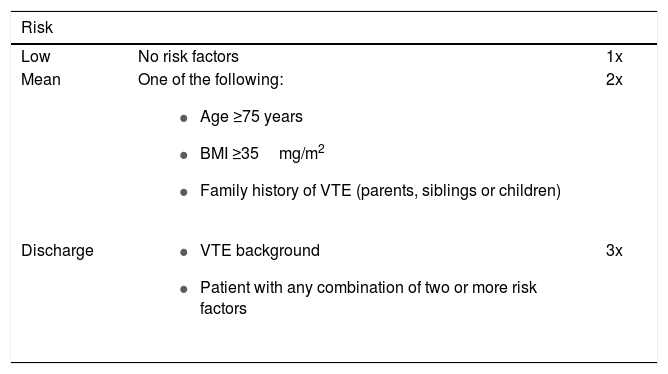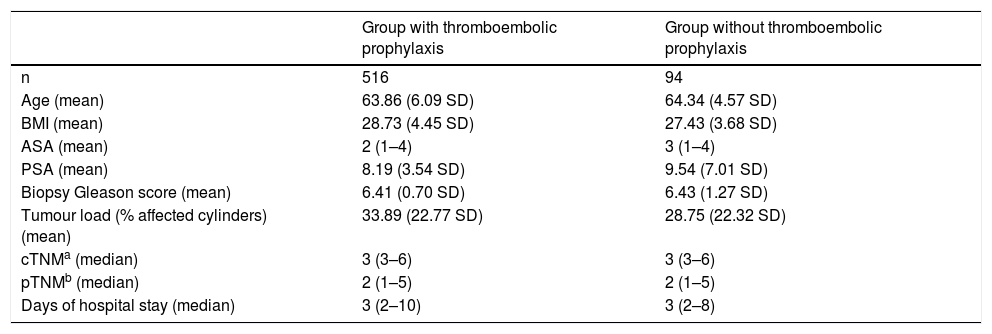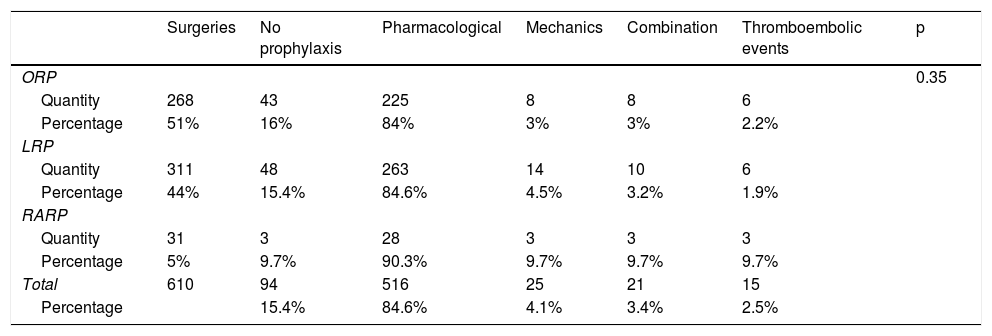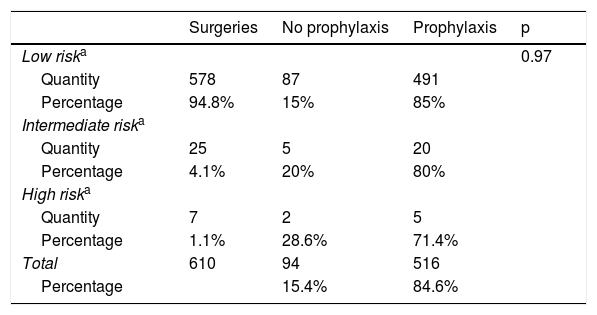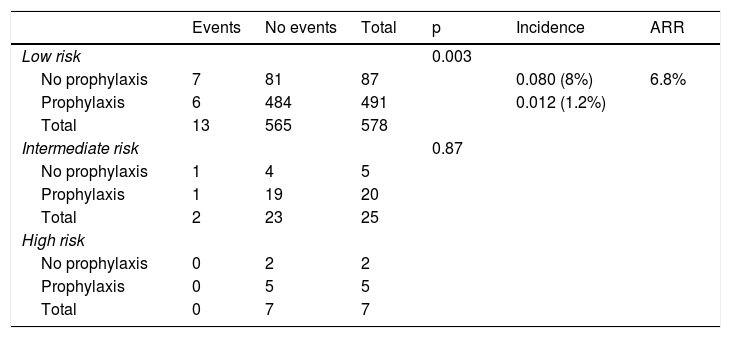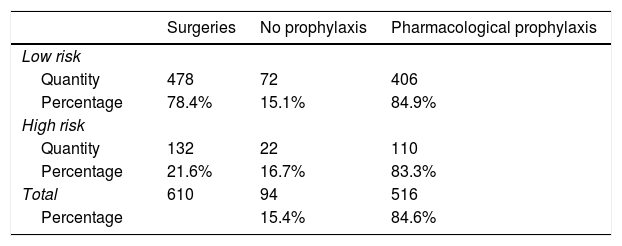Pulmonary thromboembolism is one of the most common causes of non-surgical death in patients following urological abdominopelvic surgery. Since the beginning of prophylaxis for venous thromboembolic disease, episodes of deep vein thrombosis and pulmonary thromboembolism have decreased. Our objective is to analyse the prognosis factors of thromboembolic disease, the clinical variability in the use of pharmacological prophylaxis and the results of its application.
Material and methodsRetrospective multicentric study of 610 patients undergoing radical prostatectomy between December 2013 and November 2014, in 7 general hospitals in Spain, Italy and Portugal. Patients were classified according to their baseline characteristics into thrombotic risk groups and haemorrhagic risk groups. The venous thromboembolic events that occurred in the different groups were analysed.
ResultsThe average age was 65.22 years (48–78). The average body mass index was 26.7 and the average ASA risk 2.1. In all patients, early mobilization began in the first 24h. In 4.1% intermittent pneumatic compression was used and 84.6% received pharmacological prophylaxis with low molecular weight heparins. Only 3.4% used the combination of mechanical prophylaxis with pharmacological prophylaxis. We observed a decrease in the incidence of thromboembolic events in the patients who received pharmacological prophylaxis, with an absolute risk reduction of 6.8%. There was no increase in the risk of haemorrhage in the patients who received pharmacological prophylaxis.
ConclusionsIn this study on patients undergoing radical prostatectomy, there was no difference in haemorrhagic complications derived from the use of pharmacological prophylaxis for venous thromboembolic disease. Pharmacological prophylaxis reduces the risk of presenting a thromboembolic event in patients undergoing radical prostatectomy, although this risk is not associated with the approach technique.
La tromboembolia pulmonar es una de las causas más comunes de muerte no quirúrgica en pacientes sometidos a cirugía urológica abdomino-pélvica. Desde el inicio de la profilaxis para la enfermedad tromboembólica venosa los episodios de trombosis venosa profunda y tromboembolia pulmonar han descendido considerablemente. Nuestro objetivo es analizar los predictores de la enfermedad tromboembólica, la variabilidad clínica en la utilización de la profilaxis farmacológica para esta enfermedad y los resultados de su aplicación.
Material y métodosEstudio retrospectivo multicéntrico de 610 pacientes intervenidos mediante prostatectomía radical entre diciembre 2013 y noviembre de 2014, en 7 hospitales generales de España, Italia y Portugal. Se clasificaron a los pacientes según sus características basales en grupos de riesgo trombótico y grupos de riesgo hemorrágico. Se evaluaron los eventos tromboembólicos venosos que se presentaron en los diferentes grupos.
ResultadosLa edad media fue de 65,22 años (48–78). El índice de masa corporal medio de 26,7 y la mediana del riesgo de ASA fue 2. En todos los pacientes se inició la deambulación en las primeras 24 horas. En 4.1% se utilizó compresión neumática intermitente y en un 84.6% profilaxis farmacológica con heparinas de bajo peso molecular. Solo en un 3.4% se utilizo la combinación de profilaxis mecánica con la farmacológica. Se observó disminución de la incidencia de eventos tromboembólicos en los pacientes que recibieron profilaxis farmacológica, con una reducción absoluta del riesgo de 6.8%. No se objetivó aumento del riesgo hemorrágico en los pacientes que recibieron profilaxis tromboembólica.
ConclusionesEn este estudio sobre pacientes sometidos a prostatectomía radical, no hubo diferencia en las complicaciones hemorrágicas derivadas del uso de profilaxis farmacológica para la enfermedad tromboembólica venosa. La profilaxis farmacológica reduce el riesgo de presentar un evento tromboembólico en pacientes sometidos a prostatectomía radical, si bien, este riesgo no se asocia con la técnica de abordaje.





